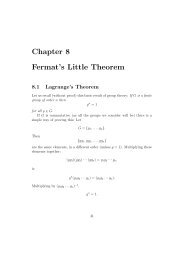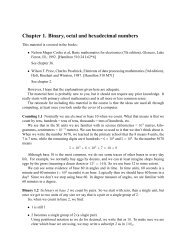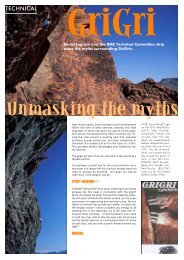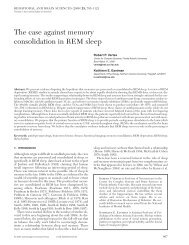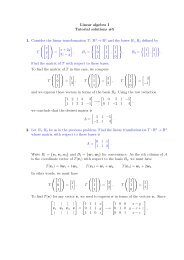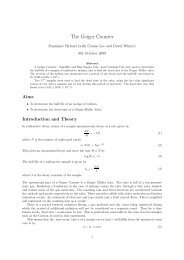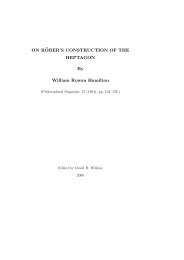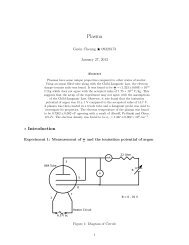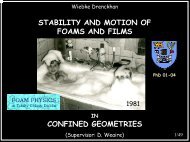Chapter 1. Some requisites
Chapter 1. Some requisites
Chapter 1. Some requisites
Create successful ePaper yourself
Turn your PDF publications into a flip-book with our unique Google optimized e-Paper software.
<strong>Chapter</strong> <strong>1.</strong> <strong>Some</strong> <strong>requisites</strong><br />
The idea here is to study a few things that are not directly part of our topic of integration, but<br />
they are things that will come up pretty soon along the way.<br />
<strong>1.</strong>1 Countable and uncountable sets<br />
You probably know very well that some sets are finite and others are infinite. The point here is<br />
that some infinite sets are more infinite than others. So there are more real numbers than rational<br />
numbers, that is the set R has a ‘greater number’ of elements than the set Q. On the other hand<br />
Q has the ‘same number’ of elements as the integers Z, even though there are many rationals<br />
that are not integers. So Z Q R but the first two are the ‘same size’ while R is ‘bigger’. To<br />
explain that, we need to approach the matter systematically.<br />
A rather abstract way of saying that a set S has n elements is to say that there is a bijection<br />
f : {1, 2, . . . , n} → S. Here the idea is that n ∈ N is a (finite) natural number. Another, perhaps<br />
more down to earth, way to express that is that S = {f(1), f(2), . . . , f(n)} so that we can list<br />
the elements of S in a list of n elements, without repetitions S = {s1, s2, . . . , sn}.<br />
You should be able to see also that the idea of listing out the elements S = {s1, s2, . . . , sn},<br />
which is probably what you would have said it means for S to have n elements, is just the same<br />
as having a bijection f : {1, 2, . . . , n} → S . (We can define f(i) = si for i = 1, 2, . . . , n.)<br />
How much further can we go? In the trivial direction if S is the empty set, we can say it has<br />
zero elements. That somehow corresponds to the case n = 0 above. What about going for bigger<br />
sets?<br />
We say that a set S is finite if it has n elements for some n = 0, 1, 2, . . .. We say S is infinite<br />
if it is not finite.<br />
Then we say that two sets S and T have the ‘same number’ of elements if there is a bijections<br />
f : S → T . (The idea is that the bijection gives us a way to pair off elements s ∈ S with elements<br />
f(s) ∈ T , and it seems to make sense then that they have equally as many elements.)<br />
Definition <strong>1.</strong><strong>1.</strong><strong>1.</strong> A set S is called countably infinite if there is a bijection f : N → S.<br />
A set S is called countable if it is either finite or countably infinite.<br />
Remark <strong>1.</strong><strong>1.</strong>2. The definition can be summarised by saying a countable set S is one where all the<br />
elements can be listed<br />
S = {s1, s2, . . .}<br />
(without repetitions) in a list that is either finite or infinite.<br />
Examples <strong>1.</strong><strong>1.</strong>3. (i) The set of integers Z is a countably infinite set.<br />
Proof. We can list all the integers Z = {0, 1, −1, 2, −2, . . .}.<br />
Every integer, positive or negative occurs in the list and occurs just once. We can use this<br />
to define a bijection f : N → Z by f(2n − 1) = −n, f(2n) = n − 1 (for n = 1, 2, 3, . . .).<br />
So we could make a more formal proof by checking that this is a bijection.
2 2011–12 Mathematics MA2224<br />
(ii) The set Q of rational numbers is a countably infinite set.<br />
Proof. We can list the rationals in Z, then the rationals with denominator 2 that are not<br />
whole numbers, then the rationals with denominator 3 that are not in the previous lists, then<br />
those with denominator 4 not listed already, etc. We get<br />
0 1 −1 2 −2 3 · · ·<br />
1<br />
2<br />
1 − 2<br />
3<br />
2<br />
3 − 2 −<br />
5<br />
3 · · ·<br />
· · ·<br />
1<br />
3<br />
.<br />
− 1<br />
3<br />
2<br />
3<br />
We can then combine all these lists into a single list (of all the rationals) by using a zig-zag<br />
pattern.<br />
0 → 1 −1 → 2 −2 → 3 · · ·<br />
That is<br />
↙ ↗ ↙ ↗ ↙<br />
1<br />
2 − 1<br />
2<br />
3<br />
2 − 3<br />
↓ ↗ ↙ ↗<br />
2<br />
↙<br />
5<br />
3<br />
1<br />
3 − 1<br />
3<br />
2<br />
3 − 2<br />
↙ ↗<br />
3<br />
4<br />
3<br />
1<br />
4<br />
↓ ↗<br />
1<br />
5.<br />
− 1<br />
4<br />
3<br />
4<br />
3<br />
· · ·<br />
· · ·<br />
<br />
Q = 0, 1, − 1<br />
<br />
1<br />
3<br />
, , −1 , −1, 2, , −1 , . . .<br />
2 3 2 2 3<br />
will be a complete list of the elements of Q.<br />
(iii) [0, 1) is an uncountable set.<br />
Proof. To prove this we rely on the fact that each x ∈ [0, 1) has a decimal expansion<br />
x = 0.d1d2d3d4 . . . =<br />
where each digit dj ∈ {0, 1, 2, . . . , 9}. A refinement we need is that we never have to use<br />
expansions that end in repeating nines. (If we do allow repeating nines, then numbers that<br />
have finite decimal expansions have another infinite one, like 0.43 = 0.42999˙9.) Excluding<br />
repeating nines, every number in the range 0 ≤ x < 1 has a unique decimal expansion.<br />
We’ll take this as known.<br />
If we assume now that [0, 1) is countable (which we aim to show is not the case) then we<br />
can list all the elements<br />
[0, 1) = {x1, x2, x3, . . .}.<br />
∞<br />
j=1<br />
dj<br />
10 j
Requisites 3<br />
Each xn has a decimal expansion (without repeating 9’s) which we write out as<br />
xn = 0.dn,1dn,2dn,3dn,4 . . . =<br />
We now show that the list we made cannot be a complete list of the numbers in the set<br />
[0, 1). We produce something that is omitted like this. Put<br />
<br />
1 if dn,n = 1<br />
and then look at<br />
dn =<br />
0 if dn,n = 1<br />
x = 0.d1d2d3d4 . . . =<br />
This will be at most as large as 0.111˙1 = ∞ 1<br />
j=1 10j = 1 < 1 and so x ∈ [0, 1). But it is<br />
9<br />
nowhere in our list. Certainly x has no repeating nines and x = xn because they differ in<br />
the nth decimal place (dn = dn,n).<br />
So the list is not a complete list. But that is true no matter what list we start with, showing<br />
that [0, 1) is not countable.<br />
Proposition <strong>1.</strong><strong>1.</strong>4. Subsets of countable sets are countable.<br />
Proof. Let S be a countable set and let T ⊆ S. It is pretty clear that subsets of finite sets are fine<br />
and so we can concentrate on the case where S is countably infinite. So the elements of S can be<br />
listed in an infinite list<br />
S = {s1, s2, s3, . . .}<br />
with no repetitions in the list. To get a list of the elements of the subset T , just remove from the<br />
list s1, s2, s3, . . . any elements not in T .<br />
This could be a finite list if T is finite, but still a complete list.<br />
Proposition <strong>1.</strong><strong>1.</strong>5. The union of two countable sets is countable.<br />
Proof. Let A and B be countable sets and list their elements in finite or infinite lists<br />
∞<br />
j=1<br />
∞<br />
j=1<br />
dj<br />
10 j<br />
A = {a1, a2, . . .}, B = {b1, b2, . . .}.<br />
Assuming first that both lists are infinite we can make a list of all the elements of A∪B by taking<br />
a1, b1, a2, b2, a3, b3, . . .<br />
but that could have repetitions. To eliminate repetitions, skip or remove any term in the list that<br />
has already occurred.<br />
If either A or B is finite, we could put a finite list at the start, then continue with the other,<br />
and then remove any repetitions. Of course, if both A and B are finite we will end up with a<br />
finite list of the elements of A ∪ B.<br />
dn,j<br />
10 j
4 2011–12 Mathematics MA2224<br />
Proposition <strong>1.</strong><strong>1.</strong>6. Every infinite set S contains a countably infinite subset.<br />
Proof. Being infinite S = ∅ and so there is an element s1 ∈ S. Then S \ {s1} can’t be empty (as<br />
S = {s1} since S is not finite) and so we can pick s2 ∈ S \ {s1}. Next pick s3 ∈ S \ {s1, s2}<br />
and inductively, once we have s1, s2, . . . , sn we pick sn+1 ∈ S \ {s1, s2, . . . , sn}. This produces<br />
an infinite sequence of elements of S with no repetitions and so a countably infinite subset<br />
{s1, s2, . . .} ⊆ S.<br />
Definition <strong>1.</strong><strong>1.</strong>7. We say that two sets S and T have the the ‘same number of elements’ if there<br />
is a bijection f : S → T .<br />
Proposition <strong>1.</strong><strong>1.</strong>8. If S is an infinite set then it has the same number of elements as a proper<br />
subset.<br />
Proof. Pick an infinite sequence s1, s2, . . . of elements of S (making a countably infinite subset)<br />
and define f : S → S \ {s1} by<br />
<br />
f(s) =<br />
s<br />
sn+1<br />
if s ∈ S \ {s1, s2, . . .}<br />
if s = sn for some n<br />
Then f is a bijection and S has the same number of elements as the subset S \ {s1}.<br />
<strong>1.</strong>2 Inverse images<br />
We will need this quite a lot. It is not such a complicated idea, but it is worthwhile getting used<br />
to it and its properties. We will be using it for R-valued functions mainly, but it works abstractly<br />
for functions f : A → B between any two sets.<br />
Definition <strong>1.</strong>2.<strong>1.</strong> If f : A → B is a function and E ⊂ B is a subset of the co-domain set B, then<br />
we define the inverse image of E under f to be the set<br />
f −1 (E) = {a ∈ A : f(a) ∈ E}<br />
Remark <strong>1.</strong>2.2. What is perhaps confusing is that the notation f −1 (E) makes sense even though<br />
the inverse function f −1 need not exist at all.<br />
Another word that can be used, instead of ‘inverse image’ is ‘pullback’.<br />
Examples <strong>1.</strong>2.3. (i) If f : R → R is f(x) = x 2 , then<br />
We can see that from the formula<br />
f −1 ([1, 4]) = [1, 2] ∪ [−2, −1]<br />
f −1 ([1, 4]) = {x ∈ R : f(x) ∈ [1, 4]}<br />
= {x ∈ R : x 2 ∈ [1, 4]}<br />
= {x ∈ R : √ x 2 = |x| ∈ [1, 2]}<br />
or by looking at the graph to see where are the x values with y = x 2 between y = 1 and<br />
y = 4:
Requisites 5<br />
Exercise. What is f −1 ((1, 4])?<br />
Another example (with the same f) is f −1 ([−10, −5]). There are no points x with f(x) =<br />
x 2 < 0 and so f −1 ([−10, −5]) = ∅.<br />
(ii) Let f : {1, 2, 5, 11} → {8, 9, 10, 11, 12} be given by the rule<br />
What is f −1 ({8, 9, 10})?<br />
f(1) = 9, f(2) = 11, f(5) = 9, f(11) = 12<br />
We can just go through the elements of {1, 2, 5, 11} one by one to see which are included<br />
and which not. f(1) = 9 ∈ {8, 9, 10} and so 1 is included. f(2) = 11 /∈ {8, 9, 10} so 11 is<br />
not included. Similarly 5 is included, but 11 is not.<br />
f −1 ({8, 9, 10}) = {1, 5}.<br />
Remark <strong>1.</strong>2.4 (Forward images). One can also look at (forward) images of sets under a function<br />
f : A → B. One such image is the whole range of f, that is<br />
f(A) = {f(a) : a ∈ A} = {b ∈ B : ∃a ∈ A with f(a) = b}<br />
but we can do something similar for any subset A0 ⊂ A. We get<br />
f(A0) = {f(a) : a ∈ A0} = {b ∈ B : ∃a ∈ A0 with f(a) = b}<br />
In the example f : R → R with f(x) = x 2 , we have<br />
and also<br />
In this case<br />
f(R) = {y ∈ R : y ≥ 0}<br />
f([0, ∞)) = {y ∈ R : y ≥ 0} = f(R)<br />
f(f −1 ([−4, 4])) = f([0, 2]) = [0, 4] [−4, 4].<br />
In general if f : A → B is a function between two sets, and if E ⊆ B, then<br />
f(f −1 (E)) ⊆ E<br />
but they need not be equal. They would be equal if f is surjective and in general one could check<br />
that f(f −1 (E)) = E ∩ f(A).
6 2011–12 Mathematics MA2224<br />
Remark <strong>1.</strong>2.5. We will have much more use for inverse images, and many nice things happen for<br />
inverse images.<br />
An example is that if f : A → B is a function and E1, E2 ⊂ B are two subsets, then it is<br />
always true that<br />
f −1 (E1 ∩ E2) = f −1 (E1) ∩ f −1 (E2) and f −1 (E1 ∪ E2) = f −1 (E1) ∪ f −1 (E2).<br />
Can you see that the statement about intersections is not true for forward images? [Hint:<br />
Look at f(x) = x 2 .]<br />
<strong>1.</strong>3 Characteristic functions<br />
If E ⊆ S is a subset of a set S, then the characteristic function of E is the function<br />
χE : S → {0, 1} ⊂ R<br />
<br />
χE(s) =<br />
1<br />
0<br />
if s ∈ E<br />
if s /∈ E<br />
So, if we take an interval like E = [1, 2] ⊂ R, then we can graph the characteristic function<br />
χ[1,2] : R → R. The graph y = χ[1,2](x) has y = 1 when x is between x = 1 and x = 2 (inclusive)<br />
but y = 0 outside that interval.<br />
A slightly more complicated example is E = [1, 2] ∪ (3, 4) and for that the graph is<br />
<strong>Some</strong>times people use the term ‘indicator function’ rather than ‘characteristic function’. You<br />
should be able to see that if you know the characteristic function χE, then you must know the<br />
subset E. In fact E is the set of points x in the domain where χE(x) = <strong>1.</strong> In fancier language, E<br />
is the inverse image of {1} under χE<br />
E = (χE) −1 ({1})<br />
Example <strong>1.</strong>3.<strong>1.</strong> The characteristic function of the rationals is a standard example of a bad function<br />
from the point of view of the Riemann integral. The graph y = χQ(x) (for x ∈ R) is not so easy<br />
to imagine, and certainly not possible to draw convincingly.<br />
We have to plot y = 1 over rational x and y = 0 over irrational x. So the graph will be quite<br />
a bit of the line y = 1 and quite a bit of the line y = 0.
Requisites 7<br />
Well, you could argue it is more of the line y = 0 because the irrationals make an uncountable<br />
set and the rationals are a smaller (countable infinite set).<br />
The Riemann integral 1<br />
0 χQ(x) dx does not exist — all upper sums are 1 and all lower sums<br />
are 0. We will see later that the Lebesgue integral will make perfect sense (and will be 0).<br />
<strong>1.</strong>4 Boolean algebra of sets<br />
The operations of union, intersection, complement, set difference, symmetric difference will<br />
come up quite soon.<br />
It is quite helpful to draw Venn diagrams of what these things mean.<br />
We consider subsets of a set S. We can call the subsets A and B, say.<br />
Union<br />
Intersection<br />
Complement<br />
A ∪ B = {s : s ∈ A or s ∈ B}<br />
A ∩ B = {s : s ∈ A and s ∈ B}<br />
A c = {s ∈ S : s /∈ A}<br />
(Notice that the complement depends in the set S we are working in. If S = [0, 1] and<br />
A = [0, 1/2], then A c = (1/2, 1], but if S = R and we have the same A, then A c =<br />
(−∞, 0) ∪ (1/2, ∞).)<br />
Set difference<br />
We can also say that A \ B = A ∩ B c .<br />
A \ B = {a ∈ A : a /∈ B}<br />
So, for instance, if A ∩ B = ∅, then A \ B = A.<br />
Another way to think of it is A \ B = A \ (A ∩ B). So to get A \ B, take away from A<br />
any elements of A that are in B (but elements of B that are not in A at all don’t get taken<br />
away, and don’t come into it).<br />
You can describe complements in terms of set difference: A c = S \ A.<br />
Symmetric difference<br />
This is the same as (A ∪ B) \ (A ∩ B)<br />
A∆B = (A \ B) ∪ (B \ A)<br />
Note: Starting with A ⊆ S, the complement A c is another subset of S. Staring with two<br />
subsets A, B ⊆ S, we get new subsets from A ∪ B and A ∩ B (and also from A \ B, B \ A and<br />
A∆B, but these are things we can make from complements, unions and intersections). So it is a<br />
kind of ‘algebra’ or manipulation with subsets.
8 2011–12 Mathematics MA2224<br />
Exercise: These operations can be expressed in terms of characteristic functions. Show for<br />
example that<br />
χA∩B(s) = min(χA(s), χB(s)) = χA(s)χB(s)<br />
<strong>1.</strong>4.1 De Morgan’s laws<br />
χA∪B(s) = max(χA(s), χB(s)) = χA(s) + χB(s) − χA∩B(s)<br />
χAc(s) = 1 − χA(s)<br />
These say that the complement of a union of subsets is the intersection of the complements, and<br />
the complement of an intersection of subsets is the union of the complements. For two subsets<br />
A, B ⊆ S, they say<br />
(A ∪ B) c = A c ∩ B c<br />
and (A ∩ B) c = A c ∪ B c ,<br />
but they actually hold for unions and complements of any collection of subsets, even infinite<br />
collections of subsets.<br />
If we want to talk about a collection of subsets of a set S, without specifying how many there<br />
are, we will usually assume that the subsets are indexed or labelled by elements of some other<br />
set I. So we will think of subsets<br />
Ai ⊆ S (for i ∈ I)<br />
and then their union and intersection are given by these definitions:<br />
<br />
Ai = {s : there is some i ∈ I with s ∈ Ai}<br />
i∈I<br />
<br />
Ai = {s : s ∈ Ai holds for every i ∈ I}<br />
i∈I<br />
De Morgan’s laws apply:<br />
<br />
i∈I<br />
Ai<br />
c<br />
= <br />
i∈I<br />
A c i<br />
and<br />
<br />
i∈I<br />
Ai<br />
c<br />
= <br />
R. Timoney January 21, 2012<br />
i∈I<br />
A c i





